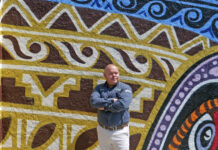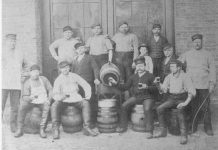This week’s cover photograph was taken in 2007 and offers a view of the Weyermann Malting Co. in Bamberg, Germany. Unsurprisingly, it is situated adjacent to the railyard.
The inaugural Rollin’ on the River Craft Beer Festival took place in Jeffersonville on Saturday and was every bit as rewarding as I’d imagined it would be (the fest was previewed here).
Our friend Caroline over at Simply PR KY offers the video (above), and a summary.
Rollin’ On The River Beer Fest was a hit among beer enthusiasts, offering a wide selection of craft beers from local and regional breweries, wineries, bourbon along with delicious food options and live music entertainment by Runaway Souls. The attendees appreciated the opportunity to taste and learn about different beer styles and enjoyed the lively atmosphere of the festival. The scenic location, The Howard Steamboat Museum nestled along the river, added to the beauty of the festival and made it a memorable experience for all.
Expect Rollin’ On The River Craft Beer Festival to return in 2025, and put it on your calendars right now. Congratulations to every last individual who combined to bring back that loving feeling we haven’t felt in Southern Indiana since the late, lamented Fest of Ale.
—
Amid the ongoing 40 (42) Years in Beer series at my website, I’ve been looking back at FOSSILS homebrewing club newsletters and noticed a reference from early 1993 about Anchor Brewing Co. beers from San Francisco becoming available in Indiana. I believe they already were in Kentucky at this point, and Liberty Ale was one of the hoppier ales around at the time.
Soon afterward Sierra Nevada came to the Hoosier state, too, and this was huge news because it was still a few years away from distribution in Kentucky, giving SoIN an edge in terms of Louisville area beer lovers who were “in the know.”
Three decades later, Anchor Brewing Co. was unceremoniously kneecapped and shuttered by its most recent absentee owner Sapporo, which had already ruined the classic labels, but now there is hopeful news, the brewery having been purchased lock, stock and intellectual property rights by Chobani yogurt mogul named Hamdi Ulukaya.
I feel the same way about Anchor as I do about Wrigley Field and Fenway Park. They all should be living, breathing National Historical Park units, preserved like Independence Hall or Keith Richards.
We can surmise that Mr. Ulukaya has a plan of action in mind for Anchor; as yet it isn’t certain if this includes nationwide distribution, as before, but the sale price includes the requisite Bay Area property, which points to a future in local and regional tourism however widely the beer is (or isn’t) shipped in the future.
Just remember that New Glarus Brewing Company does wonderfully by restricting its annual reach to the state of Wisconsin (population 5,800,000). Meanwhile 7,800,000 humans live in the metro area around San Francisco. It seems like enough.
Whatever happens, Anchor needs its key employees back in the building. Dave Infante gets down to brass tacks here: Anchor Brewing’s New Billionaire Owner Claims He’ll Bring Back Its Workers. Hold Him To It.
Ulukaya — whose personal investment fund bought Anchor, unlike La Colombe, which Chobani acquired last year for $900 million — could decide not to bring back Anchor’s old workers after all, or not to recognize its union, or some combination thereof. Given his public statements so far, that would be slimier than out-of-code yogurt, and could put a bad taste in everyone’s mouth like it, too. But billionaires are not renowned for their integrity or grasp of public opinion.
Will there be a comeback batch of Anchor’s “Our Special Ale” for Christmas this year? While it seems unlikely, I’m choosing to be optimistic.
—
More potentially good news, albeit from a smalls sampling, appeared in the comments beneath a Facebook post by Canadian beer writer Stephen Beaumont.
Brewers, who out there is stepping off the special release train and focusing more on their core line-up? Not abandoning seasonals and specialties entirely, of course, but dialing things back in accordance with reduced consumer demand.
Here’s a sampling of the encouraging responses:
MR: I hope that this becomes a trend. It is becoming too complicated to wade through all the “one-off” beers. It would be like going to a Greek restaurant because you liked a meal you had and loved the menu only to find that when you returned it was serving Thai food today, Italian tomorrow and Ethiopian next week. That grilled fish with olives you liked the first time no longer interests the chef and will never be on the menu again.
MS: We have, for a number of reasons. We’re still doing special releases but have scaled them way back in frequency. It makes our production and sales focus more manageable, and distributors are pushing back on them anyway.
SW: (I am not a brewer but) I appreciate the concept of a flagship. I stopped trying to get to x-thousand ticks on Untappd many years ago, and in my old age, finding a new shiny thing is less interesting…
DS: I’d venture to say that many breweries do not know how to do this (core/flagship beers). The advantages in cost of goods sold (COGS) and the predictability of outcomes should be welcome in most breweries. It also lets you train staff better, focus on your core message and bring innovation back into your taproom service and marketing efforts.
—
I’ve long championed cask-conditioned “real ale,” one of the glories of global beer culture. But what I never disdained was the innovation of the cask breather; in essence, it’s an ideal way of keeping hand-pumped ale fresh.
I accepted cask breathers as being necessary if we ever were able to get cask ale off the ground in America; in large measure this has not happened, alas; to be honest, I’ve put it behind me and retained a naive faith in Britain’s ability to keep the tradition alive.
However, perhaps my Anglophilia is destined to be disappointed and Brexit has sabotaged Ordinary Bitter, too.
As is his continuing and marvelous habit, Oregon-based beer writer Jeff Alworth has placed real ale right back in front of my eyes with this article, which will explain the genre of naturally carbonated beer, as well as the institution known as Campaign for Real Ale, which originated to defend it.
WHAT IF CAMRA HAD VALUED QUALITY OVER ROMANCE?
These beers should be vying with lagers as the growth style in the US, and they should be the pride of Britain. Instead, they’re unknown here and on life support there—or receding into the background as boutique beers. John laments the loss of the tradition that was once dominant in Britain. “Cask in the future will be brewed by specialist brewers for specialist pubs to be consumed by beer drinking specialists.” As we enjoy a minor renaissance of cask ale here in my region, I am especially distraught at this situation, and I wonder—was it inevitable?
As I review the case file on this tragedy, I can’t help going back to an important decision CAMRA (the Campaign for Real Ale) made and defended for decades. It was an important consumer group that rallied to save cask ale when the first signs of trouble arrived in the 1970s. They have been great advocates for cask ale, and have tens of thousands of members across the country. But the founders were beer fans and in particular writers, not brewers, and their minds were built for telling good stories. They were unsophisticated about how beer was made and sold, and they didn’t think deeply about solving real-world problems that might have helped cask ale compete with consistent, if bland, lagers.
—
Finally this week, a throwback to a peak 1970s American cultural marker, because last week was the 50th anniversary of 10-Cent Beer Night in Cleveland — and all I really want to know is whether the nearby Cuyahoga River was still burning during the drunken melee on the diamond.
Fifty years later, the chaos of Cleveland’s 10-Cent Beer Night still shocks, by Zack Meisel (The Athletic)
Fifty years ago, chaos descended upon Municipal Stadium on 10-Cent Beer Night. Now, the infamous events of June 4, 1974, when an alcohol-fueled crowd spilled onto the field, confronted players and forced a forfeit, are often viewed in a light-hearted manner, the stuff of commemorative T-shirts and parodied ballpark promotions.
But at the time? Cleveland’s sports chroniclers considered it a black eye for Cleveland on a night that resulted in many of them. Let’s travel back in time and dig into the archives of The Plain Dealer to re-live one of the most surreal scenes ever to unfold on a baseball field.
Quasi-craft mockrobrews now go for $16 at the ballyard, probably precluding future riots like the one on Cleveland 50 years ago. Come to think of it, the 1% can afford it. Maybe they’ll occupy the field and start throwing punches.
—
Previously at “Hip Hops”:




















 Roger Baylor is an entrepreneur, educator, and innovator with
Roger Baylor is an entrepreneur, educator, and innovator with 




